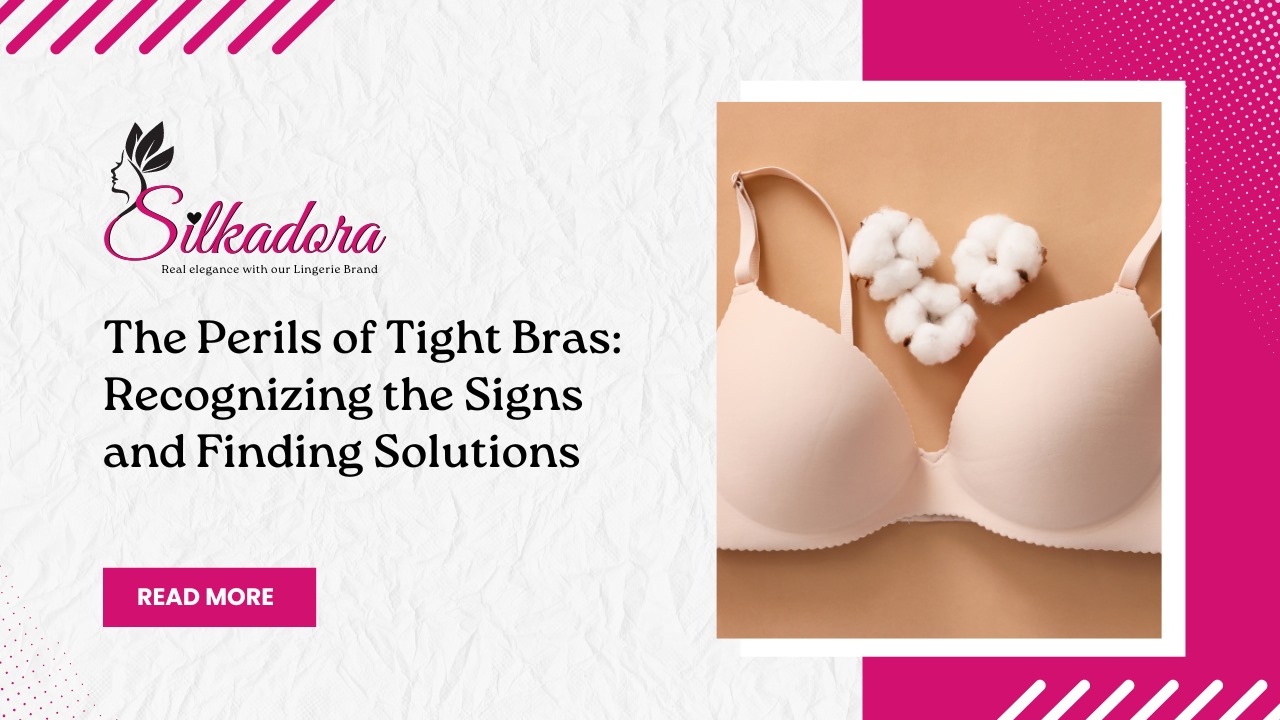Introduction to the issue of tight bras
Are you constantly tugging at your bra straps, feeling like you’re one deep breath away from a wardrobe malfunction? It might be time to address the elephant in the room (or should I say, in your lingerie drawer)…the perils of tight bras! Let’s dive into the potential health risks, signs to look out for, and most importantly, how to find that perfect balance between support and comfort. Say goodbye to discomfort and hello to a happier bust line!
The potential health risks associated with wearing tight bras
Have you ever considered the impact of wearing a tight bra on your health? While many of us prioritize style and support when choosing our undergarments, it’s essential to be aware of the potential risks that come with wearing bras that are too tight.
One common issue is restricted blood flow. When a bra is too constricting, it can interfere with proper circulation in the chest area, leading to discomfort and even potential skin irritation. Additionally, tight bras can cause shoulder pain by putting excessive pressure on the straps and digging into your skin.
Furthermore, wearing overly tight bras may also contribute to breathing difficulties as they restrict the movement of your rib cage. This can lead to shallow breathing patterns and overall discomfort throughout the day. It’s crucial to prioritize comfort alongside style when selecting your next bra!
The Importance of Proper Bra Sizing and Fitting
Ensuring the right bra size is crucial for both comfort and health. Ill-fitting bras can lead to a range of issues, from back pain to skin irritation. Proper sizing and fitting are key in preventing these problems.
Many women wear the wrong bra size without even knowing it. Getting measured by a professional can make all the difference in finding a bra that fits perfectly.
Factors like weight fluctuations, pregnancy, or simply wearing the wrong size for years can contribute to an improper fit. Regularly checking your measurements can help you stay on top of any changes.
A well-fitted bra not only provides support but also enhances your silhouette and boosts confidence. It’s worth taking the time to find bras that feel comfortable and look great on you.
Investing in bras that fit properly is an investment in your overall well-being. So, don’t underestimate the importance of proper sizing and fitting when it comes to your lingerie collection!
Signs that your bra may be too tight for you
Do you ever find yourself constantly adjusting your bra throughout the day, feeling like it’s digging into your skin? This could be a sign that your bra is too tight for you.
One common indicator is if you notice red marks or indentations on your shoulders from the bra straps. Your breasts spilling out over the cups or experiencing chafing and irritation are also signs of a too-tight fit.
If you feel restricted in breathing or experience discomfort in your ribcage area, these are additional signals that your bra may not be the right size for you. Pay attention to any back pain or headaches that might stem from an ill-fitting bra as well.
Feeling constantly aware of your undergarment, wanting to take it off as soon as possible, can indicate that it’s time to reassess the fit of your bra. Listen to what your body is telling you—it’s essential for both comfort and health.
How to properly measure and find the right bra size
Finding the right bra size is crucial for both comfort and health. To measure yourself accurately, start by wearing an unpadded bra and using a soft measuring tape. Stand straight and measure around your ribcage, just under your bust, rounding to the nearest whole number. This measurement will give you your band size.
Next, measure around the fullest part of your bust while keeping the tape level across your back. Subtract your band measurement from this second measurement to determine your cup size based on the difference in inches. For example, if there’s a 1-inch difference, you’re an A cup; a 2-inch difference indicates a B cup, and so on.
Remember that sizes may vary between brands or styles due to differences in cuts and materials used. It’s essential to try on different sizes until you find one that feels snug but not constricting. Finding the right bra size can make all the difference in how you feel throughout the day – so take the time to get it just right!
Finding comfortable and supportive bras without sacrificing style
Finding a bra that strikes the perfect balance between comfort, support, and style can sometimes feel like searching for a needle in a haystack. However, it’s essential to prioritize your comfort and health over trends or aesthetics when choosing lingerie.
When shopping for bras, opt for ones made from soft, breathable fabrics like cotton or bamboo to prevent skin irritation and discomfort. Look for styles with wide straps and bands that distribute weight evenly across your shoulders and back.
Consider trying out wireless bras or those with no underwire if you have sensitivity issues or seek extra flexibility. These alternatives can provide adequate support without compromising on comfort.
Remember that finding the right fit is key – don’t shy away from getting professionally measured to ensure you’re wearing the correct size and avoiding unnecessary tightness. Choose styles that make you feel confident while prioritizing your well-being above all else.
Alternatives to traditional underwire bras for those with sensitive skin or health concerns
For individuals with sensitive skin or health concerns, traditional underwire bras can sometimes be uncomfortable and irritating. Fortunately, there are alternative options available that provide both support and comfort without sacrificing style.
One popular alternative to underwire bras is the wireless bra. These bras offer a more relaxed fit while still providing adequate support for everyday wear. They are often made from soft materials that are gentle on the skin, making them ideal for those with sensitivity issues.
Another option is a bralette, which is a lightweight and non-restrictive alternative to traditional bras. Bralettes come in various styles and designs, offering a fashionable choice for those looking to avoid underwires.
Sports bras can also be a great alternative for those seeking comfort and support without the discomfort of underwires. They are designed to minimize movement during physical activity while providing ample coverage and breathability.
Exploring these alternatives can help individuals find suitable options that cater to their specific needs and preferences when it comes to lingerie choices.
Solutions for Finding the Right Fit and Avoiding Discomfort
Finding the right fit for your bra is crucial for both comfort and health. To avoid discomfort, start by getting properly measured. Visit a lingerie store or use online resources to determine your correct size.
Consider trying different styles and brands to find what works best for you. Look for bras with adjustable straps and bands to customize the fit. Pay attention to how the bra feels throughout the day – it should provide support without digging into your skin.
If underwires are causing issues, explore wireless options that still offer adequate support. Seamless bras can also help reduce irritation from tight seams against your skin.
Remember that our bodies change over time, so it’s essential to re-evaluate your bra size regularly. Don’t settle for discomfort – prioritize finding a bra that makes you feel supported and at ease all day long!
How to Care for Your Bras to Maintain Comfort and Avoid Tightness
Caring for your bras is essential to ensure they maintain their comfort and fit over time. To avoid tightness, it’s important to wash your bras by hand or on a gentle cycle in a lingerie bag. Avoid using harsh detergents that can damage the fabric and elastic of the bra.
After washing, reshape the cups and straps before laying them flat to dry. Hanging bras can stretch out the bands and cause discomfort later on. Store your bras neatly in a drawer or organizer to prevent them from getting tangled or misshapen.
Rotate between different bras to give each one a break between wears, allowing them to regain their shape. Avoid wearing the same bra multiple days in a row as this can lead to faster wear and tear. By taking good care of your bras, you’ll be able to enjoy long-lasting comfort without dealing with unnecessary tightness issues.
Conclusion: Embracing Comfort and Safety in Bra-wearing Habits
It’s crucial to prioritize comfort and safety when it comes to wearing bras. By recognizing the signs of a tight bra, understanding the potential health risks, and taking steps to find the right fit, you can ensure that your undergarments enhance rather than compromise your well-being.
Remember that proper bra sizing and fitting are key to preventing discomfort and health issues. Take the time to measure yourself correctly and explore different styles that offer both support and style without sacrificing comfort. Consider alternatives like wireless bras for sensitive skin or health concerns.
Care for your bras properly by handwashing them with gentle detergent and letting them air dry. Avoiding excessive heat from dryers can help maintain their shape and elasticity, ensuring long-lasting comfort.
Embracing comfortable bra-wearing habits is not just about physical well-being but also about feeling confident in what you wear every day. Prioritize your comfort, listen to your body’s signals, and choose bras that make you feel good inside out. Your body will thank you for it!










